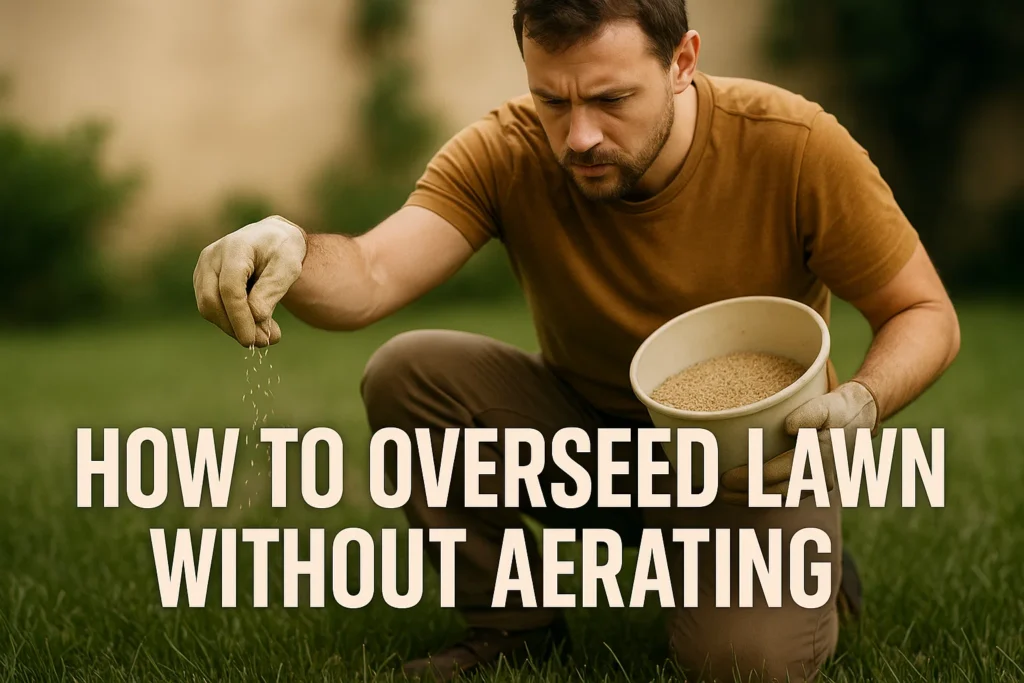Lawn overseeding is one of the simplest ways to restore thick, green health to your lawn. It consists of distributing fresh grass seed over your existing lawn to fill in bare places and enhance grass density. Overseeding is a way to help your lawn fight weeds, resist disease, and recover from damage. Though aerating before overseeding helps the seeds grow better, it’s possible to get great results without aeration if you plan and go through proper procedures. If you have soil that isn’t too compacted or are looking for a more straightforward, less expensive way to manage your lawn, this strategy could be effective.
Can You Overseed Without Aerating?
Yes, you can sow the seed without aerating, but it’s generally less successful, particularly if your soil is compacted. Aeration also breaks up the soil, allowing new seeds to better contact the dirt as they take root and grow. Without aeration, seeds struggle to touch the soil, which could result in lawns with patchy or thin growth.
No aeration before overseeding tends to work best if you already have very loose soil or perhaps recently dethatched your lawn. It’s also more effective if you start with a healthy, thick lawn and simply want to refresh it by adding more seeds. You can skip aeration if you are short on time or funds, but know that it will generally take longer to get results that are as vigorous.
To deliver better results without aerating, mow your lawn short, rake or dethatch thoroughly and spread seed evenly. You can also sprinkle a thin layer of top soil or compost over the seeds and make sure to keep the area moist for added germination.
Step-by-Step Guide to Overseeding Without Aerating
Overseeding without aerating is a potential option and can work if the lawn has been well prepared and maintained. Here are some easy steps to overseed the lawn even without an aerator:
Mow Your Lawn Short
Mow your yard shorter than normal, about 2 inches in height. This allows new seeds to access soil and sunlight, promoting better growth.
Rake and Remove Debris
Use a garden rake to remove dead grass, leaves and other debris. It allows more of those seeds to come into contact with the soil, giving them a better chance to germinate.
Spread Grass Seed Evenly
Spread grass seed evenly over your lawn with a seed spreader. Use the planting rate listed on the seed package to prevent over- or under-seeding.
Lightly Rake Seed Into Soil
And after seed is broadcast, work lightly over the area with a leaf rake or something similar to help integrate seeds more into the surface of the soil for better contact.
Optional: Spread a Thin Layer of Compost or Soil on Top
A thin layer (approximately 1/8 inch) of compost or fine topsoil can provide some protection for seeds, enhance moisture retention and promote contact between the seed and soil.
Water Consistently
Immediately after seeding, water your newly seeded lawn gently but thoroughly. Water lightly once to twice a day to keep the soil moist until new grass is established.
Fertilize After Germination
Once young and tender grass shoots show then give it starter fertilizer to help those roots grow strong.
Common Mistakes When Overseeding Without Aerating
| Common Mistake | Reason |
| Poor Soil Preparation | Seeds won’t contact soil well, hurting growth |
| Spreading Too Much or Little Seed | Leads to patchy or overcrowded lawn |
| Overseeding at Wrong Time | Seeds may fail to germinate |
| Not Watering Properly | Seeds dry out or get washed away |
| Mowing Too Early or Late | Can damage young grass or allow weeds |
| Using Wrong Seed Type | Grass won’t grow well in your region |
| Skipping Fertilizer | New grass lacks nutrients for strong growth |
When You Still Might Need Aeration
If you have compact or hard soil, you may need to aerate your lawn. Aeration loosens the soil, which helps air, water and nutrients flow to grassroots more easily. This is important if your lawn gets a lot of use, has clay soil or if you have patches where the grass doesn’t want to grow.
The best times for aeration will vary by your type of grass:
- Kentucky bluegrass, fescue or ryegrass cool-season grasses are best aerated during late summer into early fall. That timing helps roots establish themselves before winter and provides the foundation for a lush, green lawn in spring.
- For grasses such as Bermudagrass, zoysiagrass, and St. Augustinegrass aerate in late spring to early summer so that the seeds will be able to reestablish before cooler weather comes. This is conducive to fast growth during the growing season.
However, if you do overseed without aerating and subsequently see poor grass growth or compacted soil, then don’t worry: Aeration during either the fall (September-November) or spring (April-June) can help return your lawn to good health.
As a rule, aerate before overseeding or after the new grass has sprouted if your soil could use some work. So, take it from me and aerate your lawn during the growing season for nice healthy thick grass and great overseed results.
Tips to Maximize Seed-to-Soil Contact Without Aeration
- It is recommended to cutt your lawn short, about 2 inches high.
- Rake well to clear dead grass, leaves, and dirt.
- If needed thatch the area to allow some of the shared to penetrate.
- Use a spreader to distribute grass seed evenly for uniform coverage.
- Cover the seeds lightly with a thin layer of compost or fine topsoil.
- Lightly drag the area to blend the seeds with the soil surface.
- Water the area lightly and frequently to maintain moist soil until the grass is established.
Conclusion
Overseeding your lawn is a great thing to do when you want to keep a nice thick, healthy and green lawn. Mowing short, raking clean, casting seed evenly and watering regularly can prepare the way if adding grass seed without pre-aeration proves necessary. Timing your overseeding properly and perhaps even lightly applying a thin layer of compost or topsoil will enhance the likelihood of success.
Contact Revamping Lawn for professional and customized overseeding and aeration services for your lawn.
FAQ’s
Yes, but aerating makes seeds grow up quicker and thicker.
Late summer or early fall if growing a cool-season grass; late spring or early summer for warm season.
Mow close, take away scattered debris with a rake and loosen soil surface.
Water soil daily until grass has been established.
So choose a seed mix appropriate for your locale and your lawn.



